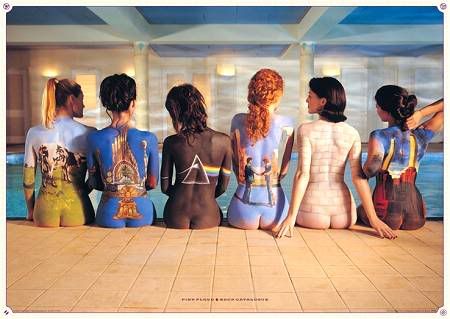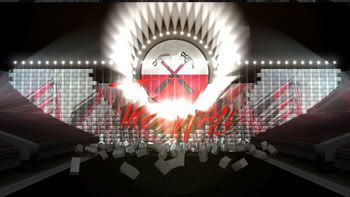Roger Waters performs "The Wall" at the United Center on Sept. 20. View more pictures of Roger Waters and '"The Wall" at the United Center HERE. (Scott Strazzante, Tribune)
http://leisureblogs.chicagotribune.com/turn_it_up/2010/09/concert-review-roger-waters-performs-the-wall-at-united-center.html
"Roger Waters showed up Monday to begin a four-night residency at the sold-out United Center, but the lean, silver-haired former Pink Floyd mastermind was no match for the spectacle he created.
Waters took second billing to “The Wall,” the soundtrack, and the wall, the edifice that was built fabricated brick by fabricated brick until it towered over the performance, sealed off the performers, and then – spoiler alert! -- collapsed during the finale. Who needs “Wicked”? This was mega-Broadway staging with a stadium-rock score and a top ticket price to match -- $250 plus service fees..
Is it worth it? If you loved “The Wall” in its original 1980 stage creation you’ll probably love it now, if only as nostalgia on the grandest, gaudiest possible scale; Waters treats his score like a sacred text, not to be messed with in any way, certainly not by the hired guns he employed to replicate it (the Chicago run closes with performances Tuesday, Thursday and Friday).
How well has it aged? As multimedia extravaganza, it was in many ways a spectacular update, rather than an overly faithful replication of the original stage show. Parts of “The Wall” soundtrack came off as a period piece, an overwrought relic of a rock era when size mattered. There’s enough filler in this wall to make its eventual collapse seem inevitable. But for a work about madness, excess is to be expected and "The Wall" creates its own world convincingly. Its musical high points are still stirring, whether it’s the plaintive cry of “Mother,” the alternately desperate and menacing "Hey You," the paranoid gallop of "Run Like Hell" or the epic, stately descent into madness that is “Comfortably Numb.”
Waters brought a 12-piece band with him (including his son Harry on keyboards) to replicate the 1979 Pink Floyd classic, which has since sold more than 23 million copies in the U.S. The work had previously been performed only 31 times, in part because it was such an expensive and elaborate undertaking, until Waters reclaimed it for his current tour. In terms of scale and ambition it dwarfs his 2006 solo tour, in which he performed another Floyd landmark, “The Dark Side of the Moon,” in its entirety.
But “The Wall” is also a more problematic work than the fat-free “Dark Side,” with its bombastic production and heavy handed narrative. Its place in pop-culture history is assured, however; after “The Wall,” everything else in rock seemed puny, probably for the best. Once you go this high -- this gonzo, really -- it’s probably a good idea to back away slowly. Indeed, a few years after its creation, Waters and the Floyd parted ways forever (except for a brief reunion at Live 8 in 2005).
For the 2010 incarnation, Waters put a bigger geo-political twist on the narrative, freshening up some of the visuals to emphasize current events as much as the internal psychodrama of the rock opera’s protagonist. “The Wall” as originally presented came across as a highly personal work – essentially a Waters solo album with the rest of Floyd reduced to his backing band. It focused on the narrator’s insecurities and paranoia: the death of his father in World War II, the smothering attention of his mother, the betrayal of his wife, the brow-beatings of various authority figures, until he becomes isolated from society – literally walling himself off from the world. In its new telling, Waters uses the wall as a symbol of the cultural, political and racial barriers that divide nations. Images of Iraqi war victims merged with those of earlier conflicts; bombs became corporate logos; and flags of an imagined dictatorship were marched on and off stage at various intervals -- as if "The Wall" weren't stuffed enough already with ideas and eye candy.
The wall constructed through the first half of the show becomes a massive canvas for Waters and his visual collaborators to splash a sensory overload of images, slogans and garish cartoons. Monstrous inflatable puppets – domineering mother, ominous schoolteacher, carnivorous lover as half-woman, half-praying mantis – descended from the rafters to loom over and terrorize Waters. The sounds of birds-turned-bombers, helicopters, trains and cars zoomed around the arena, thanks to an elaborate array of speakers.
Waters dueted with the stark black-and-white version of his younger self performing "Mother" in England in 1980 -- an oddly moving and effective moment in a song where childhood dreams give way to a desperate search for answers. For "Comfortably Numb," the dramatic lighting used for David Gilmour's original showstopping moment -- his giant silhouette spilling across the balconies as he soloed -- was replicated, right down to the solo itself. Waters spread his hands overhead, glorying in the moment with the audience.
When the bassist assumed the guise of a dictator complete with trench coat and arm band, the show became a commentary on despotism of all kinds, including the rock concert itself. Big Brother cameras watched the audience's every move and insisted on passivity -- "Trust Us," "Everything Will be OK." As Waters and some of his musicians gave a cross-armed fascist salute, many audience members responded in kind -- as if to prove Waters' point that a strong-willed leader can manipulate a crowd to do his bidding. Rock concerts are trumpeted as celebrations of individuality and rebellion, but Waters pointedly saw them as just another type of political rally. That's not necessarily a new idea, but rarely has it been illustrated as chillingly.
For at least one listener, "The Wall" makes its most moving statement amid the rubble of its finale. In front of the toppled wall, the musicians assembled as a ragtag Salvation Army band, with stringed instruments, accordion and Waters on trumpet. They paid tribute to "the bleeding hearts and the artists," the outcasts who can't help "banging your heart against some mad bugger's wall." One senses that for the Roger Waters who created "The Wall," the bleeding-heart artists and mad buggers had a lot in common. "





 ... HUGE fan!!!
... HUGE fan!!!

 ... Infinite and Eternal Salut ... They made my life and the world better!!!
... Infinite and Eternal Salut ... They made my life and the world better!!!








